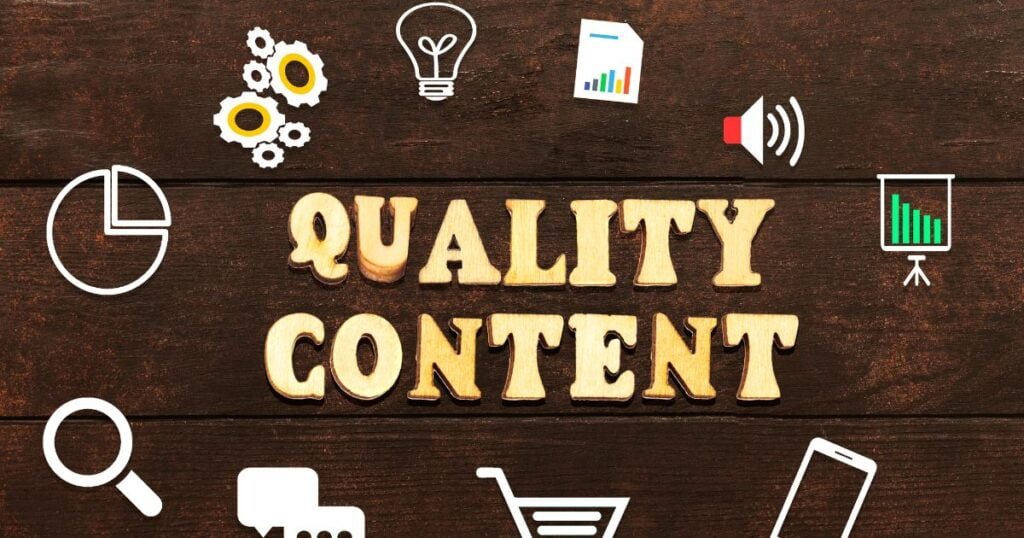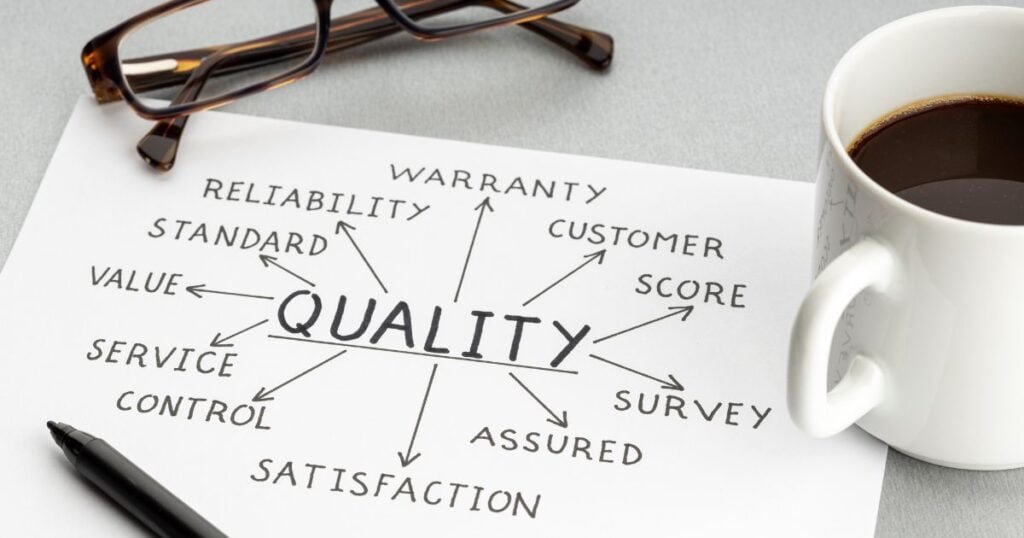Content marketing has become an essential strategy for businesses looking to attract and engage with customers in the digital age. High-quality, valuable content helps build trust, establish expertise, and drive qualified traffic to websites and sales funnels. However, with the sheer volume of content being produced today, creating content that stands out takes strategic planning and effort.
At its core, content marketing involves creating and sharing various types of media and publishing informative, relevant content to attract a target audience. The content can take many shapes—from long-form blog posts and eBooks to videos, podcasts, and social media graphics. But no matter the format, high-quality content is crucial for cutting through the noise.
Content quality check grabs attention in crowded niches and helps build brand awareness and loyalty among customers. Well-executed content marketing informs audiences and provides real value at each stage of their buyer’s journey. Businesses that invest resources into creating premium, useful content are more likely to see greater ROI from their marketing efforts overall. This guide will explore the key elements of high-quality content and the steps any brand can take to improve its content.
Definition of Content Quality

Content quality refers to how useful, valuable, and engaging content is for a target audience. High-quality content meets the needs and interests of readers by providing original information and insight. Several key elements contribute to overall content quality:
- Relevance – Content should directly relate to the topic and align with what the target audience cares about. It answers their key questions and fits their search intent.
- Accuracy – All facts, statistics, quotes, and other details in the content need to be completely accurate and error-free. Quality content is thoroughly researched and validated.
- Depth – The best content provides an appropriate level of detail and analysis for the topic. It expands on the basics to deliver truly useful information.
- Clarity – Content needs to be well-structured and easy to follow. Quality writing uses plain language suited for the intended audience.
- Uniqueness – Rehashing existing content adds no value for readers. Original, fresh perspectives and ideas set quality content apart.
- Visual appeal – Images, charts, videos, and other media enhance the content experience when used purposefully. They should support the written content.
- Timeliness – Content quality considers when the information is most relevant. Some evergreen topics stay pertinent for years, while other content requires more frequent updating.
Meeting all the quality criteria results in content that educates, informs, helps, or entertains readers as intended. Useful content earns authority with its audience and achieves marketing goals.
Also Read: Boutique Marketing Agency: Top Boutique Marketing Agencies to Elevate Your Business
Importance of High-Quality Content

High-quality content is essential for effective marketing and brand-building in the digital age. Investing the time and resources into creating stellar content provides numerous benefits:
- Increased trust and loyalty from your audience – Readers can easily recognize low-effort or automatically generated content. Providing original, well-researched, and insightful content that meets their needs shows you respect your audience. This helps build credibility and long-term relationships.
- Better rankings and traffic from search engines – Search engines like Google are constantly evolving to detect and rank high-quality pages above low-value, thin content. Optimizing content for relevance, depth, and engagement signals can lead to higher organic search rankings.
- Higher conversion rates – Quality content presented in an engaging format leads to lower bounce rates and more pages per visit. By captivating visitors’ interest, they are more likely to take your desired actions and convert into customers or subscribers.
- Improved brand awareness and thought leadership – Comprehensive, authoritative content allows you to highlight your brand’s expertise and shape industry conversations. Readers who find your content valuable are more likely to remember and recommend your brand.
- Ongoing value and long-term assets – Unlike short-lived campaigns and ads, high-quality evergreen content continues providing value over months or years. This content can be repurposed into other formats and serves as an asset to build your brand’s digital presence.
Key Elements of Content Quality Check

Successful content starts with understanding your target audience and aligning your content to their interests and needs. Writing in a clear and compelling style keeps readers engaged from start to finish. Ensuring accuracy and credibility establishes trust, while visual appeal makes the content more enjoyable and shareable. Let’s explore these key elements of high-quality content:
Relevance and Alignment with Audience
Content should directly speak to the needs, interests, and preferences of your ideal audience. Conduct audience research to identify demographics, pain points, and motivations. Map out customer journeys to determine goals and gaps. With a deep understanding of your audience, you can create tailored content that grabs attention and provides real value.
Clear and Engaging Writing Style
Well-written content uses simple words, active voice, descriptive language, and varied sentence structure. Break up long blocks of text with headers, visuals, and white space. Weave in narrative elements like stories and analogies to spark the imagination. Write conversationally like you’re speaking to a friend. These techniques make copy relatable, memorable, and enjoyable to read.
Accuracy and Credibility
High-quality content is founded on truth, evidence, and expertise. Vet sources thoroughly. Cite credible references where appropriate. Link out to original research. Fact-check meticulously. Avoid unsubstantiated claims or exaggerations. Readers value content they can trust. Building authority takes time, but losing credibility can happen overnight.
Visual Appeal
Appearance matters – especially online. Use photos, graphics, videos, charts, and infographics to illustrate key points. But don’t go overboard. Visuals should supplement writing without creating clutter. Ensure images are high-resolution, relevant, and creatively made. Well-designed content looks polished, professional, and easy to digest. Visually striking content also gets higher engagement across social media.
Also Read: The Most Common Goals in Search Engine Optimization (SEO) Poisoning
Optimizing Content for SEO
Search engine optimization (SEO) is a crucial aspect of content marketing success. High-quality content that ranks well in search engines provides tremendous value for businesses trying to reach and convert target audiences. There are two main components of optimizing content for SEO: keyword optimization and user experience.
Keyword Research and Integration
Conducting thorough keyword research to identify relevant terms and phrases is the first step to optimizing content. This provides insight into what users are searching for so content can be crafted around those queries. Keywords should be organically integrated into content to help pages rank for the identified terms. This includes using keywords naturally in headings, opening paragraphs, image alt text, meta descriptions, and 1-2 times in the body content. Over-optimization should be avoided.
User Experience and SEO
Google and other search engines are focused on providing the best user experience and satisfying search intent. So, content must be created to meet user needs, not just target keywords. Factors like readability, loading speed, mobile-friendliness, interactivity, and value/uniqueness of information all impact user experience. Content that engages users provides a positive experience, and makes it easy to find answers is rewarded by search engines.
Optimizing content for both users and search engines is critical. With insightful keyword research and creating content that solves user queries, pages can rank highly and convert searchers into customers.
Content Structure
The structure and formatting of content have a significant impact on its readability and ability to engage readers. A logical flow that connects ideas coherently is essential.
Readability
- Use short paragraphs with one main idea each to make the content scannable.
- Avoid dense blocks of text. Break up long paragraphs.
- Use headings and subheadings to organize the content into logical sections.
- Apply bullet points or numbered lists for key information.
- Bold key terms and phrases to direct the reader’s attention.
- Use plain, conversational language. Avoid complex vocabulary when simpler words will suffice.
- Define any necessary technical terms or jargon.
Logical Flow
- Structure the content to follow a natural progression of ideas.
- Open with an introduction summarizing the purpose and scope.
- Build on concepts step-by-step. Explain any prerequisites before presenting new information.
- Use transitions to connect paragraphs and ideas smoothly.
- Close with a conclusion recapping the main points.
- Check that the order and relationships between sections make sense.
- Ensure each paragraph has a clear role within the overall narrative flow.
Revision and Editing
Producing high-quality content requires an iterative editing process. One round of editing is rarely enough—content should go through multiple revisions to refine and polish it.
The editing process should include:
- Self-editing by the author to fix any grammar, spelling, or formatting issues. Authors should read through the draft carefully to catch any errors.
- Peer-editing by a colleague to provide a fresh perspective. They can identify areas that are unclear or need more explanation.
- Professional editing by an editor or proofreader. They will nitpick details and ensure writing is tight, flows well, and is free of errors.
- Testing and feedback rounds. Run drafts by target users to gather feedback. Use analytics to see what resonates.
- Final approval by all stakeholders before publishing.
Invest time upfront in multiple editing rounds. This leads to more polished content that builds credibility and trust with readers. Rush jobs with minimal editing undermine quality.
Use tools to assist the editing process:
- Spelling and grammar checkers in word processors. But don’t rely solely on them.
- Readability metrics like Flesch-Kincaid to assess ease of reading.
- Plagiarism detectors to check for copied content.
- Text-to-speech tools to hear how the writing flows.
Proper editing and revision result in engaging, error-free content. It takes more time than just a single pass but elevates the quality substantially.
Promoting Audience Engagement
Engaging your audience and promoting interactivity should be a key goal of any high-quality content. There are several strategies you can use:
Encouraging Comments and Feedback
- Make it easy for readers to comment on your content on your website or social platforms. Enable comments and reply to any substantive feedback.
- Ask open-ended questions in your content to spark discussion. For example, “What has been your experience with X?”
- Promote polls and surveys to get direct feedback from readers. Tools like SurveyMonkey and Google Forms make it easy.
- Highlight interesting comments and your responses. This shows you value user contributions.
- Incentivize comments through giveaways and contests for commenters.
Call-to-Action (CTA) Strategies
- Include strategic calls to action in your content to drive conversions. For example, CTAs to download an ebook, register for a webinar, sign up for a trial, etc.
- Place CTAs both in the middle and end of the content. Some readers may not make it to the end.
- Make CTAs visually stand out through color, size, and placement, but don’t distract from content.
- Test different CTA wording like “Download Now” vs. “Get the Free eBook.” Track conversions to see which performs best.
- Ensure CTAs link directly to landing pages for a seamless user experience.
Measuring Content Performance
Quality content success should be measured beyond vanity metrics like shares and likes. Here are the key metrics to track:
- Traffic sources: Analyze where your traffic is coming from, whether organic search, social media, email, referrals, etc. This indicates how well your distribution strategy is working.
- Bounce rate: The percentage of visitors that leave your site after viewing only one page. Lower bounce rates mean your content resonates with readers.
- Time on page: Are visitors spending time reading your content? Higher times indicate engaging content.
- Scroll depth: How far down on the page are people scrolling? More scroll depth means interested readers.
- Social engagement: Track likes, shares, and comments on social. This shows how effectively your content spreads.
- Links and mentions: Monitoring brand mentions and links from external sites indicates your authority and influence.
- Conversions: Ultimately, quality content should convert readers into customers and drive business goals like sales.
Analyzing these metrics provides data-driven insights into how high-quality your content really is for your audience. Continuously optimize to improve engagement, conversion, and ROI.
Also Read: 8 Crucial Pros and Cons of SEO Search Engine Optimization
Maintaining Quality Over Time
Producing high-quality content is an ongoing process that requires maintenance and vigilance over time. As a website’s content ages, it runs the risk of becoming outdated, inaccurate, or less engaging for audiences. Brands should take steps to audit and update their content libraries regularly.
Ongoing Audits
Conduct content audits on a quarterly or bi-annual basis to evaluate what content needs to be refreshed or replaced. Look for pages with dated information, broken links, and media, or thin content that needs to be fleshed out. Prioritize updating evergreen pillar content that appears at the top of key searches.
Updating Old Content
Don’t just archive old content pages. Take the time to update statistics, replace outdated facts or trends with current information, and incorporate new media like videos, infographics, and gated content offers. This keeps the content alive and prevents it from going stale over time. Repurpose and expand on evergreen content topics that still align with audience needs.
Monitoring for Technical Issues
Check that links, images, videos, and other media still function properly. Links that result in 404 errors should be removed or replaced. Perform monthly technical audits to catch any creeping technical problems.
Optimizing and Improving
Treat content updates as opportunities for optimization. Look for ways to improve page speed, break up dense text with multimedia, improve headings and page titles, and enhance visual appeal. User feedback and metrics can point the way toward impactful improvements.
With a thoughtful process in place, brands can ensure their content remains timely, useful, and engaging for audiences over the long haul. Consistent quality keeps visitors satisfied and loyal.
FAQs
1. Why is content quality important for online presence?
High-quality content is essential for building trust and credibility online. It not only engages your audience effectively but also contributes to improved search engine rankings, driving organic visibility and traffic.
2. How can I assess the quality of my written content?
To evaluate written content, ensure your message is clear and concise. Check for proper grammar and punctuation, provide relevant and valuable information, and maintain a compelling tone that resonates with your target audience.
3. Are visuals crucial for content quality?
Yes, visuals are paramount for content quality. Incorporate high-resolution images, infographics, or videos that complement your message. Visual appeal not only captures attention but also enhances the overall user experience.
4. Can tools help in content quality checks?
Leverage tools such as Grammarly and Hemingway Editor for grammar and readability analysis. These tools assist in refining your writing, ensuring it is error-free, easy to understand, and aligns with best practices.
5. What role does consistency play in content quality?
Consistency in style, tone, and branding across content is pivotal. It establishes a professional and cohesive brand image, fostering trust with your audience. A unified approach enhances recognition and reinforces your brand’s identity.
Conclusion
In conclusion, prioritizing content quality is the linchpin for a successful online presence. It builds trust, engages audiences, and boosts visibility. Regularly assess your content for clarity, grammar, and visual appeal. For more insights on optimizing your content for SEO and enhancing overall quality, visit SEOJust – your go-to resource for actionable strategies. Elevate your content game and watch your online presence flourish. Start optimizing today with SEOJust!




